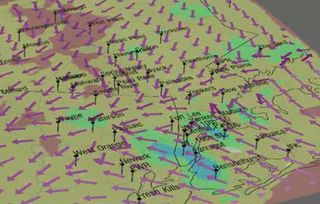IBM Supercomputer Model Forecasts Hurricane Irene's Impact

Hurricane Irene's looming threat on the weather forecast may compel you to stock up on bottled water and put up the shutters, but cities and businesses must also worry about dealing with flooded streets, emergency evacuations and power outages. Luckily, some have begun turning to an IBM supercomputer model that can help them decide on a practical response regarding anything from rainstorms to blizzards.
The "Deep Thunder" simulation not only delivers precise weather forecasts up to three days ahead of time for client cities or businesses, but also predicts possible storm damage on city or business infrastructure such as the power grid. Such information can help cities decide how many snow plows to put on the streets, or aid utility companies in sending out repair crews to fix downed power lines.
"We have to think about the business impact question," said Lloyd Treinish, chief scientist for IBM's Deep Thunder. "If all we can do is the weather, we haven't solved the problem yet even if there's value in the improved weather prediction."
Deep Thunder has already begun simulating the possible impact of Hurricane Irene for clients in New York City, as well as IBM's own labs located around New York State. It can provide anywhere from 24- to 84-hour forecasts depending on what the client needs and how much data is available.
"In general, the first 24 hours will be more accurate (e.g., for thunderstorms)," Treinish said. "But we have seen circumstances where we don't see a lot of difference in accuracy even three days ahead."
IBM previously did weather predictions for Florida during Hurricane Wilma in 2005. The National Weather Service forecasts had showed heavy rainfall and strong winds in Miami, but Deep Thunder more accurately predicted where rainfall would take place and showed how most of the hurricane threat would come from gusty winds.
Building better predictions
Sign up for the Live Science daily newsletter now
Get the world’s most fascinating discoveries delivered straight to your inbox.
That's not to say IBM is trying to steal the thunder of the National Weather Service — the latter uses much of IBM's hardware and software technology. But whereas the National Weather Service must provide broad weather forecasts for the entire United States, IBM works with commercial clients to create more precise forecasts tailored to their needs.
"The National Weather Service has a very challenging mission of dealing with an entire country," Treinis told InnovationNewsDaily. "But what matters at the smaller scale of a utility company or city is very much dependent on local geographic constraints such as coastlines, rivers and topography."
Deep Thunder can draw data from weather stations operated by partner private networks — such as WeatherBug — or from weather sensors operated by a client city or business. It also uses public information from sources such as NASA and the National Oceanic and Atmospheric Administration that runs the National Weather Service.
Next, IBM's models consider the physics of how local geography and conditions affect even a monster storm such as Hurricane Irene. The urban geography and "urban heat island" effect of Manhattan can make for different weather conditions than what might take place near a much smaller city such as Providence, R.I.
The business impact
Modeling the physics of weather is just the first part of Deep Thunder's equation. The second part comes from simulating the exact layout of sewers, storage tunnels, buildings and power lines that could suffer storm damage from heavy rainfall, lightning strikes or flooding.
If all that's in place, Deep Thunder can figure out what seasonal and local weather conditions may lead to, say, the power going out. The culprit may be wind and fallen trees in one area, or the accumulation of snow and ice on power lines in another area. Historical weather data can also help predict the weather's impact on a business or city.
"You may have a common set of weather data in that you have both historical forecasts and historical measurements of wind, rain, temperature, humidity, but not all of it may be correlated to damage and impact," Treinis explained.
One North American utility company has worked with IBM to create a weather and outage prediction service to pinpoint such damaging effects of storms that can affect its 90,000 poles, wires and transformers. Deep Thunder can help position repair crews near the likeliest spots for storm damage, and even predict the number of workers who may be needed up to 72 hours before a storm.
Personalized weather forecasting
Deep Thunder won't directly help individuals plan whether they should cancel or go ahead with weekend driving, shopping or other plans ahead of Hurricane Irene — IBM is focused on bigger business clients. But the capability is there, and Deep Thunder is serving cities where people live and work.
"The individual's question about whether he or she should paint the house today or plan a barbecue is the same kind of problem a utility company might face, but it's obviously just a different scale of economic and societal impact," Treinis said.
Some IBM employees have actually used Deep Thunder's information to help decide whether to hold a barbecue or go sailing in the past, Treinis said. They may do that again as Deep Thunder tracks Hurricane Irene sweeping up the U.S. East Coast.
This story was provided by InnovationNewsDaily, a sister site to Live Science. You can follow InnovationNewsDaily senior writer Jeremy Hsu on Twitter @ScienceHsu. Follow InnovationNewsDaily on Twitter @News_Innovation, or on Facebook.

